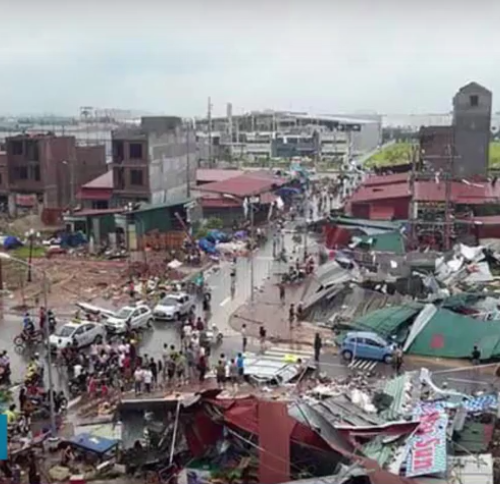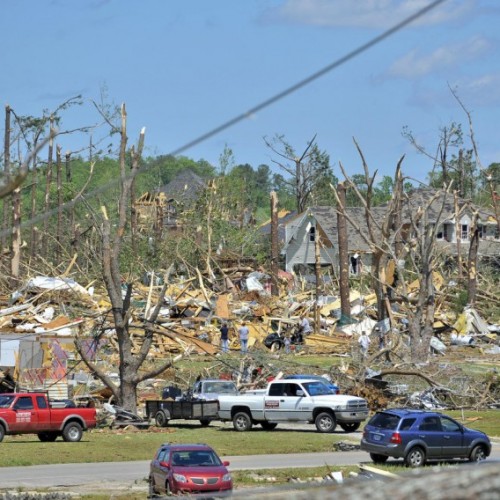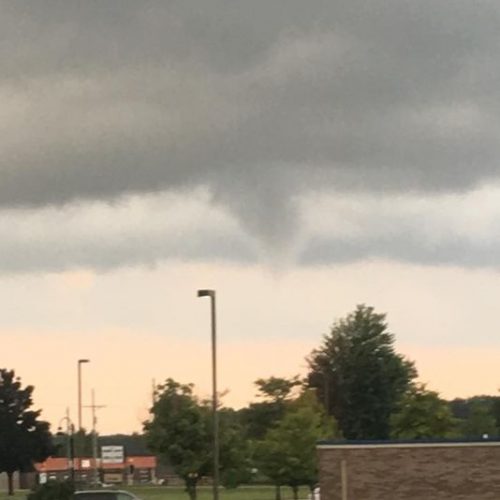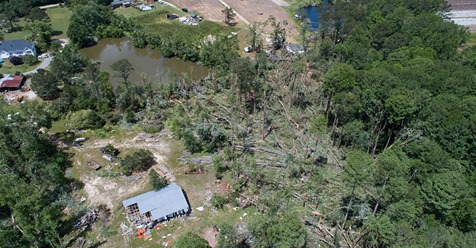HARI SREENIVASAN: Storms, hurricanes and natural disasters clearly test the fortitude of any area, as we’re seeing this weekend with Hermine, and just recently with the rains and flooding in Louisiana.
We tend to focus on the immediate aftermath and relief, but the devastation can last for years.
We have the story of how one city leveled by a tornado has spent years rebuilding, and in some ways is better and stronger for the future.
The tornado that struck Joplin, Missouri, on May 22, 2011 was one of the most destructive ever in U.S. history; 161 people were killed, 1,000 were injured, and more than 7,000 homes were damaged.
When the “NewsHour” visited four months later, people were still literally picking up the pieces of their lives.
JANE CAGE, Chair, Citizens Advisory Recovery Team: It is certainly clean, compared with what it used to be.
HARI SREENIVASAN: Jane Cage, a businesswoman who chaired the Citizens Advisory Council to rebuild Joplin, told us back then she was worried people wouldn’t come back to the destroyed areas.
JANE CAGE: In the beginning, I think everyone said, I want to rebuild my house. And now I think people are faced with the reality that what they wanted, their neighborhood and their friends may not be in that same spot.
HARI SREENIVASAN: Five years later, Cage took us on a tour of the same neighborhood.
JANE CAGE: I think this is, in some ways, one of the best recovered neighborhoods. They’re nicer houses and larger houses overall.
HARI SREENIVASAN: She says one of the main things that Joplin got right in the aftermath was encouraging residents to stay.
JANE CAGE: We concentrated on keeping our population in Joplin, because we saw what happened in other cities that experienced disasters. And I think one of the first things that we did to make that happen was, our school superintendent made the promise that we would start school on time.
HARI SREENIVASAN: Five schools were completely wiped out in the storm, including Joplin High School. When we visited in 2011, classes had just begun in an abandoned shopping mall.
Now a brand-new state-of-the-art high school has opened on the original site. It’s just across the street from where sophomore Blake Dean’s house was flattened. Dean described how he rode out the storm in a backyard shelter.
BLAKE DEAN, Sophomore, Joplin High School: Sure enough, we start hearing a kind of freight train noise. And it just starts getting really loud and the pressure starts building. And then we all kind of just huddled up in the shelter, and it just blew over it.
HARI SREENIVASAN: His family chose to rebuild on the same lot a bigger and better house. And he says the school is also bigger and better.
BLAKE DEAN: Oh, it’s just awesome. It’s so — I mean, it’s so much bigger than the last one and there’s so much more opportunity.
HARI SREENIVASAN: In fact, bigger and better is how many in Joplin now describe the city as a whole. The population has actually grown by 1,000 people over the last five years.
And fellow high school football player Maurice Aubrey says the sense of community has become stronger too.
MAURICE AUBREY, Sophomore, Joplin High School: Now we have this single past experience that links us all together, as before. So, it just makes it — it’s made it so much better, I think.
MARCINDA HEMPEN, Joplin Resident: My complex was this portion right here, and my apartment was right here.
HARI SREENIVASAN: Marcinda Hempen is one of those people who took advantage of those new opportunities. She was living in an apartment and huddled in the bathtub when the storm passed through.
MARCINDA HEMPEN: The weirdest thing was, after it was all done, it was so quiet that I thought, am I dead? Did I not make it? Is this what it’s like to be dead?
HARI SREENIVASAN: Hempen, a single mom of two now-grown boys, said, prior to the storm, she couldn’t afford to buy a house, but thanks to a $20 million federal loan program which helped her with a down-payment, she owns a home in one of the hardest-hit areas.
MARCINDA HEMPEN: It’s still a little unreal. I own this. This is all mine. I can paint a wall. I can do whatever I want to do, and nobody can tell me different.
HARI SREENIVASAN: The community-wide effort, along with help from all levels of government and hundreds of volunteer organizations from around the country, has changed the face of the city. Nearly 2,000 new homes have been built; 300 new businesses have opened. And thanks to $30 million from the federal government, the city has a new sewer system, new electrical grid, and new storm shelters in every school and public building.
There are also new parks, complete with basketball courts, playgrounds and water features. St. John’s Mercy Hospital, which was completely destroyed, has been rebuilt on a new site, and has $11 million worth of upgrades to protect from future tornadoes, including windows that can sustain winds up to 250 miles an hour, fortified safe zones on every floor, and a 450-foot reinforced tunnel, which houses generators, water and data communications.
But for all of the signs of new growth in Joplin, there is one area where the healing has been more difficult. Cases of mental distress and trauma have more than doubled over the past five years, affecting people like Marian Kelly, who showed us the crawl space where she rode out thee storm.
MARIAN KELLY, Joplin Resident: But, at some point I felt the air getting sucked out of the crawl space around me. And I thought, this is how I’m going to die.
HARI SREENIVASAN: She was relatively lucky. Her house was damaged, but not destroyed, and she emerged with just some cuts and bruises. But the emotional scars have been much deeper.
MARIAN KELLY: For me, the post-traumatic stress disorder has manifested itself mostly in a heightened emotional response to things. I get anxious or upset in ways that I wouldn’t have before. Also, the concentration issues are there. That’s why there’s alarms for everything on my phone. That’s why everything has to be written down.
HARI SREENIVASAN: She has been able to hold down a job, but she says that’s thanks to medication and regular counseling sessions. She’s not sure she will ever fully recover.
MARIAN KELLY: It’s been difficult for me to accept that I might not get all of this back, the things that I have lost. I have shaved off a few I.Q. points, you know? And I don’t know if I can expect there — to get them back.
HARI SREENIVASAN: While Kelly still struggles with her memories of that terrible day, she is proud of the city for showing such resilience in the aftermath.
She is also hopeful that the many young people who have moved to Joplin since the storm will bring new energy and life to the community.
That new life is evident in the downtown, which had been largely abandoned before the tornado hit. Now it’s dotted with hip restaurants, bars and lofts.
Rachel Grindle, who just moved to Joplin from Long Beach, California, is impressed.
RACHEL GRINDLE, Joplin Resident: Our first week living in Joplin, we were invited to Friday night wine share, which is this networking group for people our age who are career-minded and city-focused. And after that, everybody came here to Infuxn afterwards. And we went out to dinner after that.
And I looked at my husband, and I was like, I feel like we’re living more of the L.A. lifestyle in Joplin than we ever did in Long Beach.
HARI SREENIVASAN: Reminders of the storm can still be found everywhere in Joplin, whether it’s the memorials to the people who lost their lives, or to the miles and miles of treeless neighborhoods.
But five years later, the signs of progress that have emerged from that tragic day have become a model for other communities who have suffered catastrophic disasters.
By Hari Sreenivasan, September 2, 2016 at 6:30 PM EDT
Photo by Benjamin Krain / Getty Images
“Much of Joplin, Mo., seen here on May 24, 2011, lies in rubble after a massive tornado passed through the town, killing more than 100 people, on May 22. It has been called the deadliest single tornado in the U.S. in 60 years”






